The Incredible Life of Frederick Douglass
The story of Frederick Douglass’s life is, at turns, tragic and awe-inspiring. He is a testament to the strength and ingenuity of the human spirit. The Henry Ford is fortunate to have some materials related to Douglass, as well as to the many areas of American history and culture he touched. What follows is an exploration of Frederick Douglass’s story through the lens of The Henry Ford’s collection, using our artifacts as touchpoints in Douglass’s life. 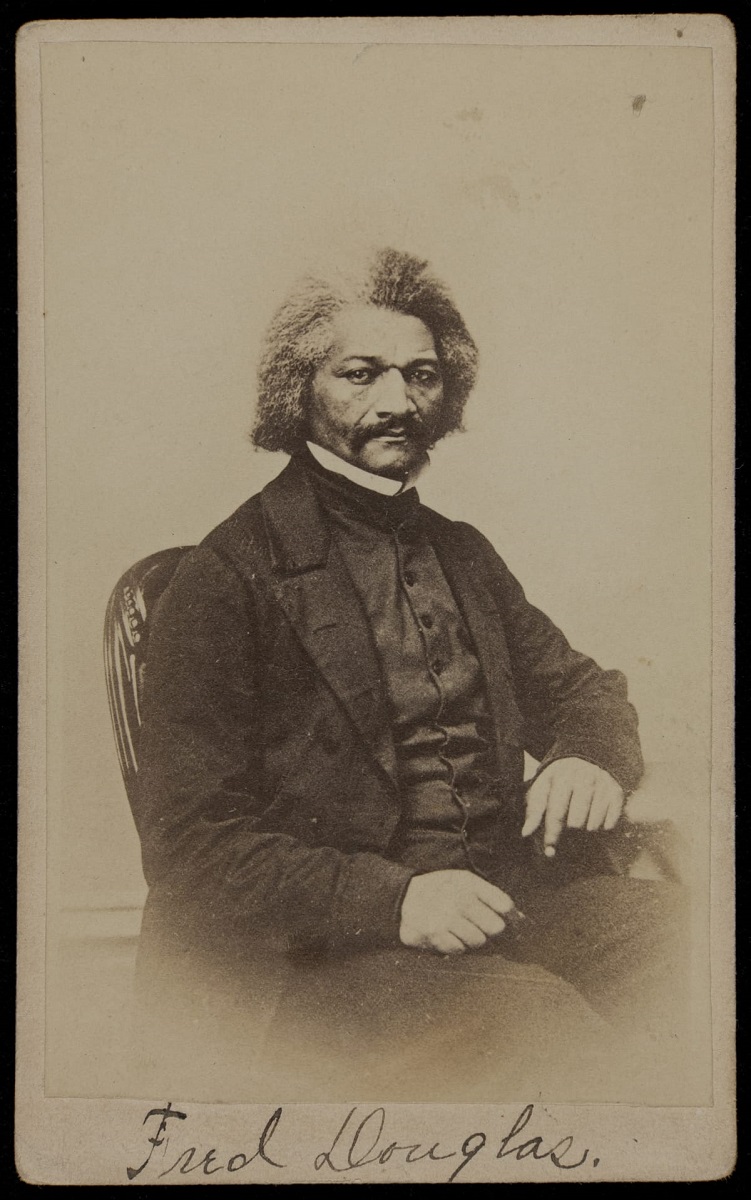
This portrait of Douglass was taken circa 1860, around the time Abraham Lincoln was elected the 16th president of the United States. / THF210623
Early Life & Escape
Born into slavery in Talbot County, Maryland, Frederick Douglass was named Frederick Augustus Washington Bailey by his enslaved mother, Harriet Bailey. Tragically, Douglass only saw his mother a few times before her early death, when Douglass was just seven years old. Though he had few memories of his mother, he recalled her fondly and was proud to learn that she also knew how to read. He wrote that he was “quite willing, and even happy, to attribute any love of letters I possess” to his mother. Few enslaved people could read at that time—Douglass’s pride in his mother was certainly justified.
In 1826, Douglass was sent to Baltimore, Maryland, to live with the family of Hugh and Sophia Auld—extended family of his master, Aaron Anthony. This move to Baltimore would be transformative for Douglass. It not only exposed Douglass to the wider world, but was also where Douglass learned to read.
Douglass was initially taught to read by Sophia Auld, who considered him a bright pupil. However, the lessons were put to a stop by Hugh Auld. It was not only illegal to teach an enslaved person to read, but Hugh also believed literacy would “ruin” Douglass as a slave. In a sense, Douglass agreed, as he came to understand the vast power of literacy. Douglass would later remark that “education and slavery are incompatible with each other.”
Douglass was determined to read. He “converted to teachers” some of the friendlier white children in the neighborhood. They showed him a school reader entitled The Columbian Orator, by Caleb Bingham, that he came to rely upon. In 1830, he purchased his own copy for 50 cents. The book—a collection of exceptional oration, poems, dialogue, and tips on the “art of eloquence”—became a great inspiration to Douglass. He carried it with him for many years to come.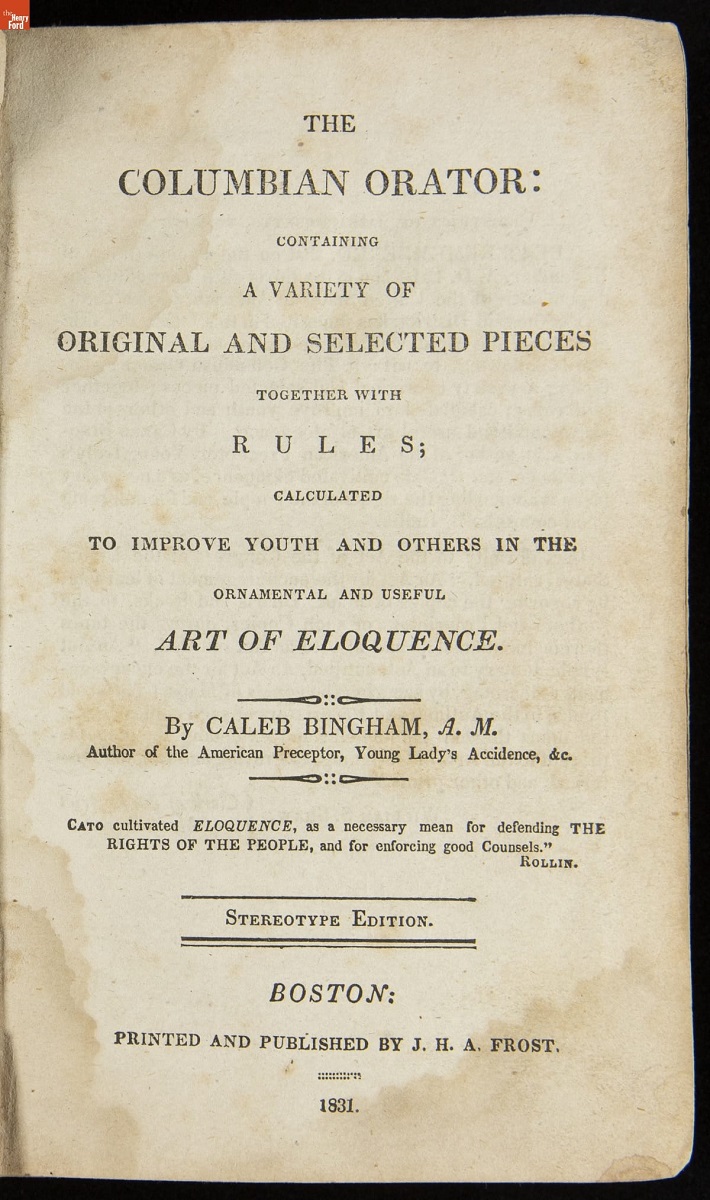
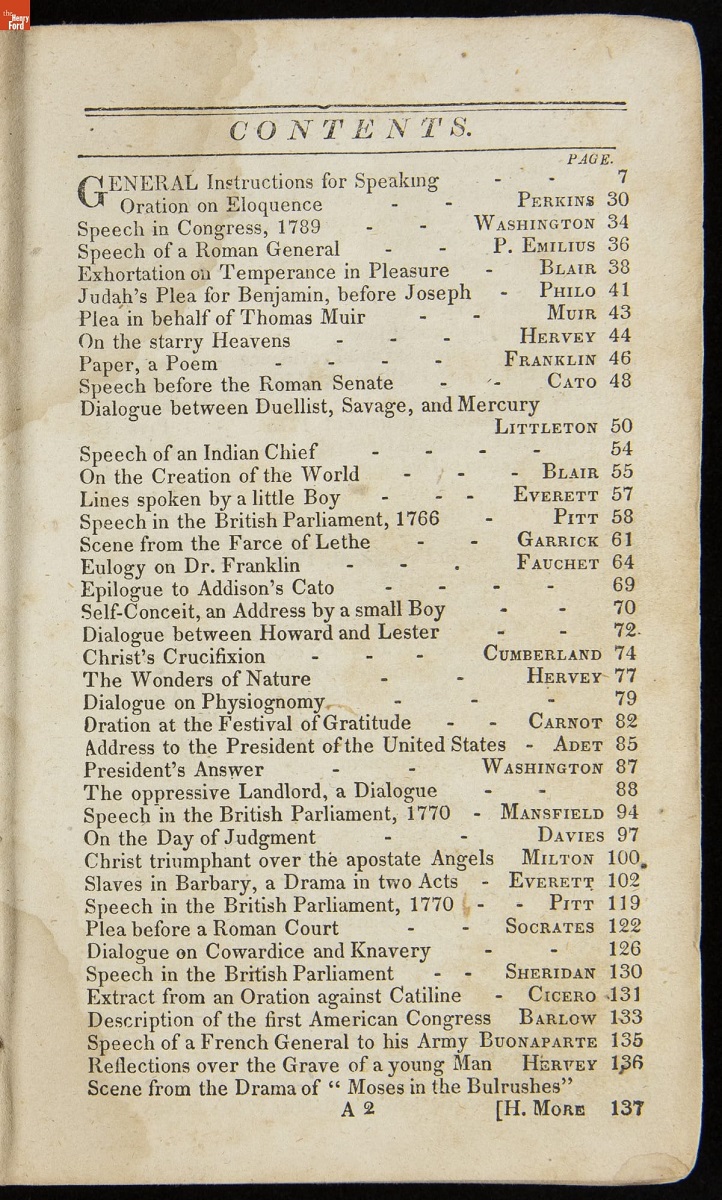
“The Columbian Orator” features a discussion between an enslaved person and their master which impressed Douglass. The enslaved person’s dialogue—referred to as “smart” by Douglass—resulted in the man’s unexpected emancipation. / THF621972, THF621973
As recollected in his first memoir, Narrative of the Life of Frederick Douglass, an American Slave, published in 1845, Douglass’s teenage years were some of his most challenging. He became viewed as a “troublemaker.” He was hired out to different farmers in the area, including one who had the reputation as an “effective slave breaker” and was especially cruel. Knowing that a larger world awaited and facing a terrible quality of life, Douglass attempted an escape in 1836. The escape failed and he was put in jail. Douglass was surprised to be released. He was sent not to the deep South as he had feared, but instead, back to Baltimore and the family of Hugh Auld, to learn the trade of caulking at the shipyards. While working there, Douglass was subjected to the animosities of his white coworkers, who beat him mercilessly—and were never arrested for it because a white witness would not testify and the word of a Black man was not admissible. He continuously dreamt of escape.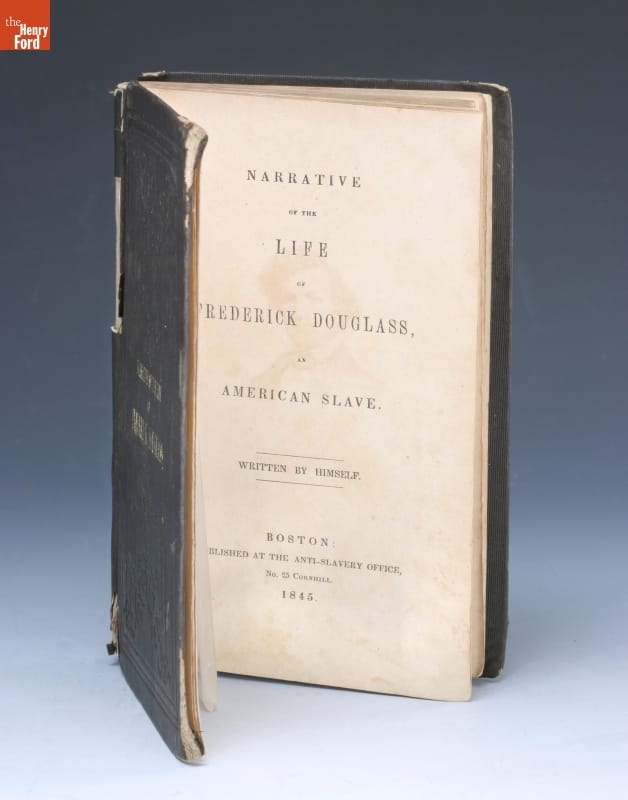
In this first memoir, Douglass provides great detail into his early life. However, because he was still a fugitive at the time of publication, he omitted details related to his escape. / THF8133
Recalling the ships on Chesapeake Bay, Douglass wrote:
“Those beautiful vessels, robed in purest white, so delightful to the eye of the freemen, were to me so many shrouded ghosts, to terrify and torment me with thoughts of my wretched condition. You are loosed from your moorings and are free; I am fast in my chains and am a slave! You move merrily before the gentle gale, and I sadly before the bloody whip!”
The ships’ freedom taunted him.
On September 3rd, 1838, Douglass courageously escaped slavery. Dressed as a sailor and using borrowed documents, he boarded a train, then a ferry, and yet another train to reach New York City—and freedom. His betrothed, Anna Murray Douglass, a free Black woman, followed, and soon after they were married. Frederick and Anna Murray Douglass moved to New Bedford, Massachusetts, with hopes that Frederick could find work as a caulker in the whaling port. Instead, he took on a variety of jobs—but, finally, the money he earned was fully his. It is believed that Anna Murray Douglass played a crucial role in supporting Frederick's escape. Their shared commitment to freedom made them a formidable team in the fight against slavery.
The American Anti-Slavery Society & the Abolitionists
While living in New Bedford, Douglass encountered William Lloyd Garrison’s abolitionist newspaper, The Liberator, for the first time. Douglass later wrote that the paper “took its place with me next to the Bible.” The Liberator introduced to Douglass the official abolitionist movement. This was a pivotal moment in his journey to becoming a prominent abolitionist leader.
In August of 1841, Douglass attended an abolitionist convention. In an impromptu speech, he regaled the audience with stories of his enslaved past. William Lloyd Garrison and other leading abolitionists noticed—Douglass’s career as an abolitionist orator had begun. Douglass became a frequent speaker at meetings of the American Anti-Slavery Society. His personal story of life enslaved humanized the abolitionist movement for many Northerners—and eventually, the world. His powerful speeches resonated deeply, inspiring many to join the cause.
In 1845, he published his first memoir, Narrative of the Life of Frederick Douglass, an American Slave. By 1847, it had already sold more than 11,000 copies! This would be followed by two more memoirs: My Bondage and Freedom in 1855 and Life and Times of Frederick Douglass in 1881. These narratives became essential texts in the abolitionist movement and the aftermath of the Civil War, providing firsthand accounts of the horrors of slavery.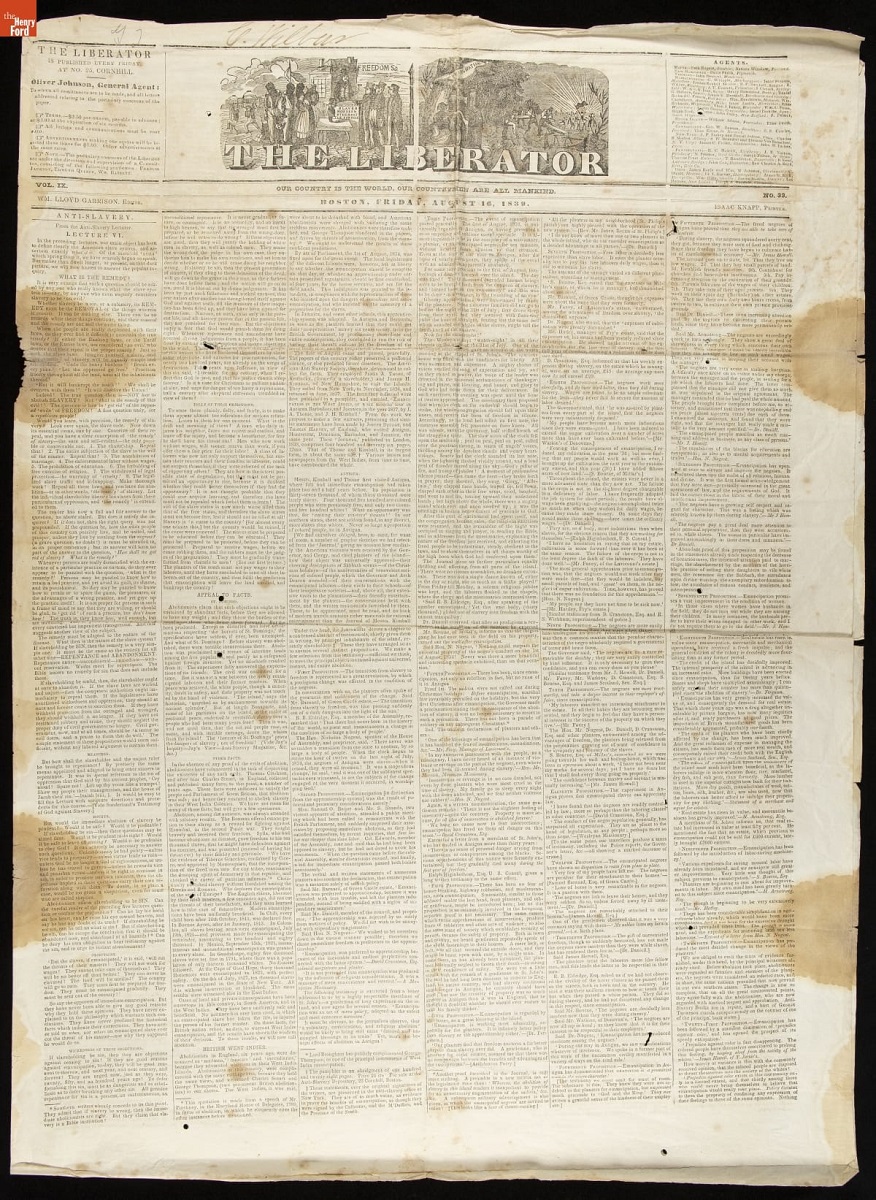
This copy of William Lloyd Garrison’s The Liberator was published on August 16, 1839—around the time when Douglass first encountered the paper. / THF621979
Women’s Suffrage
Douglass was also supportive of the women’s suffrage movement. He spoke at the famous Seneca Falls Convention of 1848 in support of women’s rights. In fact, the motto of his newspaper, The North Star, was “Right is of no sex—Truth is of no color—God is the Father of us all, and we are brethren.”
While Douglass forcefully supported women’s suffrage, some of his actions put him at odds with others in the movement. He supported the adoption of the 14th amendment, ratified in 1868, which guaranteed equality to all citizens—which included Black and white males, including the formerly enslaved. It did not include women. He also supported adoption of the 15th amendment, ratified in 1870, which secured Black males voting rights. Again, the amendment excluded women. Although a dedicated women’s rights activist, Douglass supported the adoption of the 14th and 15th amendments as he believed the matter to be “life or death” for Black people. This put him in disagreement with Elizabeth Cady Stanton and Susan B. Anthony, two of the leaders of the women’s suffrage movement, as well as his friends. Despite this disagreement about timing, Douglass would continue to lecture in support of women’s equality and suffrage until his death.
John Brown’s Raid
Douglass was well-acquainted with famous abolitionist leader John Brown, first meeting him in 1847 or 1848. Brown became known for leading a raid on the armory at Harpers Ferry, Virginia, in 1859, intending to create an “army of emancipation” to liberate enslaved people. Douglass and Brown spoke shortly before John Brown’s raid. Brown had hoped that Douglass would join him, but Douglass declined. He believed that Brown was “going into a perfect steel trap, and that once in he would not get out alive.”
Douglass was right. Brown was captured during the raid and was subsequently tried, convicted, and executed. Brown became seen as an anti-slavery martyr, as the below print shows. Henry David Thoreau remarked about him, “No man in America has ever stood up so persistently and effectively for the dignity of human nature…”
A letter from Douglass was found among John Brown’s belongings, leading to warrants for Douglass’s arrest as a conspirator. He was lecturing in Philadelphia at the time of the discovery. John Hurn, Philadelphia’s telegraph operator, was sympathetic to the abolitionist cause. He received a dispatch for the sheriff calling for Douglass’s arrest and both sent a warning to Douglass and delayed relaying the dispatch to the sheriff. Douglass fled and made it to Canada, narrowly escaping arrest. He then went abroad on a lecture tour, resisting apprehension in the States.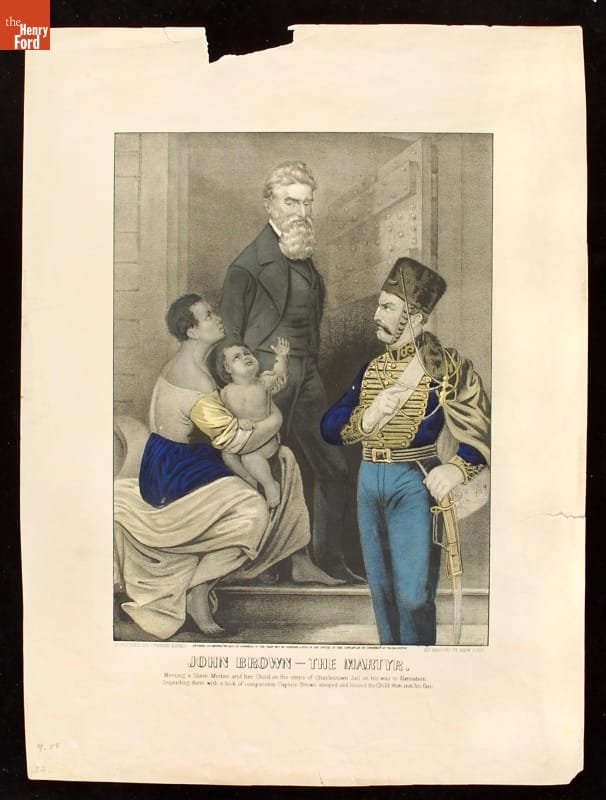
The text on this Currier & Ives print reads “John Brown—The Martyr: Meeting a Slave Mother and her Child on the steps of Charlestown Jail on his way to Execution. Regarding them with a look of compassion Captain Brown stooped and kissed the Child then met his fate." This did not actually occur, but became popular lore, as well as the subject of artwork and literature. / THF8053
The Civil War & Abraham Lincoln
In 1860, Abraham Lincoln was elected President of the United States. At the time, Douglass was not optimistic about the cause of abolition under Lincoln’s presidency. As tensions between the North and South grew and Civil War loomed, Douglass welcomed the impending war. As biographer David Blight states, “Douglas wanted the clarity of polarized conflict.”
Douglass got involved in the war effort through the recruitment of Black soldiers. Two of his sons, Charles and Lewis, joined the 54th Massachusetts Regiment, the second Black regiment in the Union Army. Douglass first met President Abraham Lincoln in August 1863, when he visited the White House to discuss grievances against Black troops. Even without an appointment and a room full of people waiting, Douglass was admitted to see Lincoln after just a few minutes.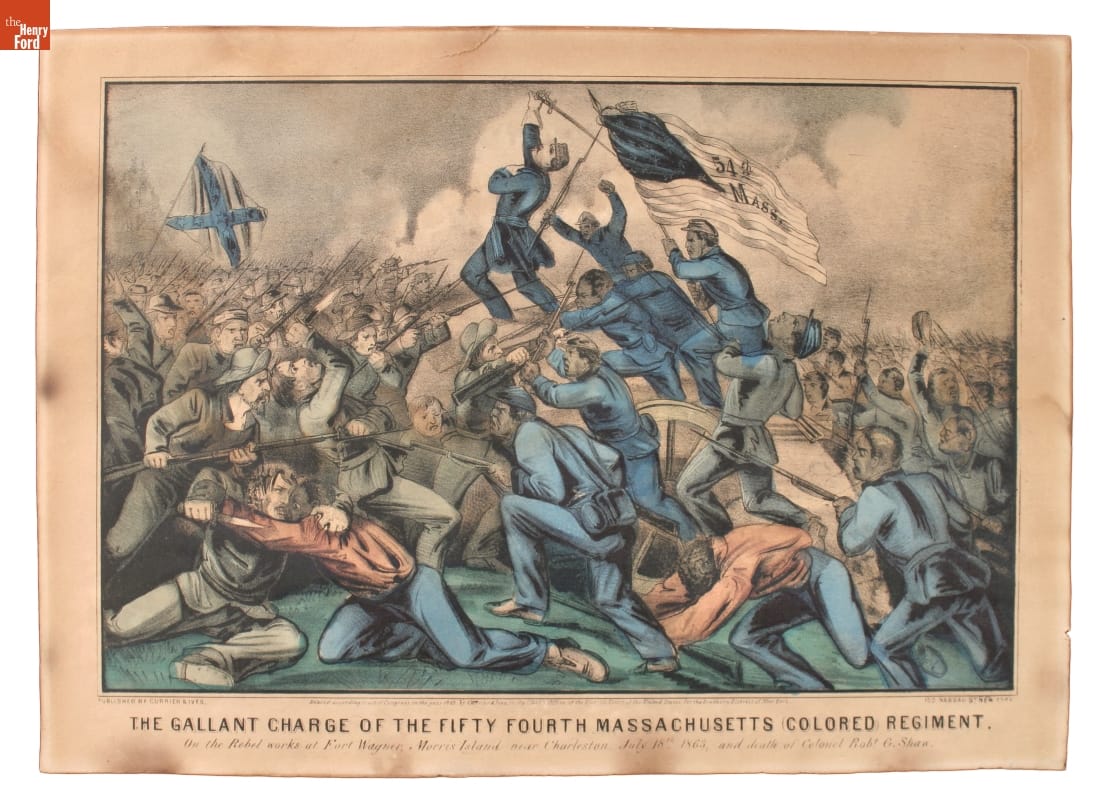
Two of Frederick Douglass’s sons, Lewis and Charles, fought with the 54th Massachusetts Colored Regiment. Lewis Douglass was appointed Sergeant Major, the highest rank that a Black person could then hold. / THF73704
Douglass would go on to advise Lincoln over the following years. After Lincoln’s second inaugural address, he asked Douglass his thoughts about it, adding, “There is no man in these United States whose opinion I value more than yours.”
On February 1, 1865, Lincoln approved the Joint Resolution of the United States Congress proposing the 13th Amendment to the Constitution—the “nail in the coffin” for the institution of slavery in the United States. But before the 13th Amendment could be ratified, Lincoln was assassinated by John Wilkes Booth on April 15, 1865. While Douglass and Lincoln certainly disagreed on many topics, Douglass remembered him fondly. In his eulogy, Douglass called Lincoln “the Black man’s president: the first to show any respect to their rights as men.”
After the Civil War and even after Reconstruction, Douglass held high-ranking government appointments—often becoming the first Black person to do so. Douglass was appointed the Minister Resident and Consul General to Haiti in 1889.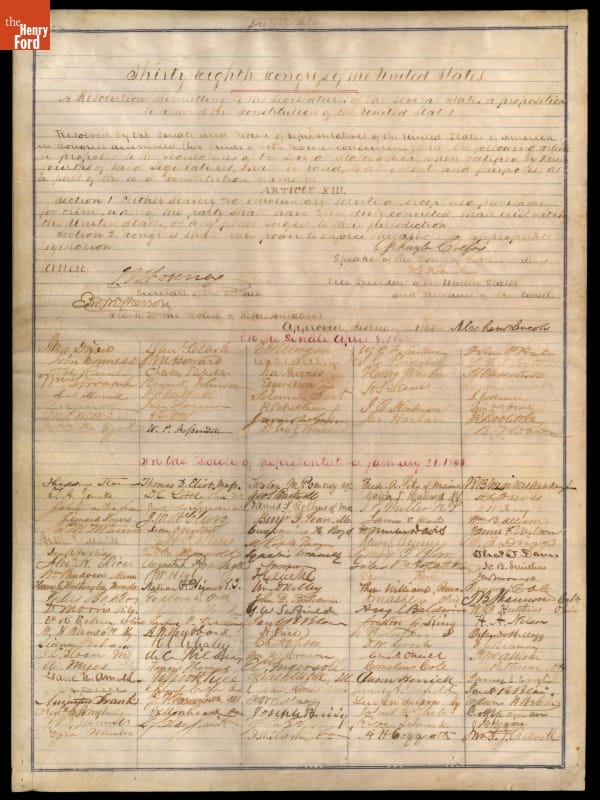
While Douglass certainly supported the 13th Amendment’s abolition of slavery, he did not think it went far enough. He remarked, “Slavery is not abolished until the black man has the ballot. While the legislatures of the south retain the right to pass laws making any discrimination between black and white, slavery still lives there.” / THF118475
Douglass continued to lecture in support of his two primary causes—racial equality and women’s suffrage—until the very end. On February 20, 1895, he attended a meeting of the National Council of Women, went home, and suffered a fatal heart attack. He was 77 years old.
Frederick Douglass remains one of the most inspirational figures in American history. We can still feel the weight of the words he wrote and spoke, more than 125 years after his passing. Douglass said, “Memory was given to man for some wise purpose. The past is … the mirror in which we may discern the dim outlines of the future and by which we may make it more symmetrical.” This work continues.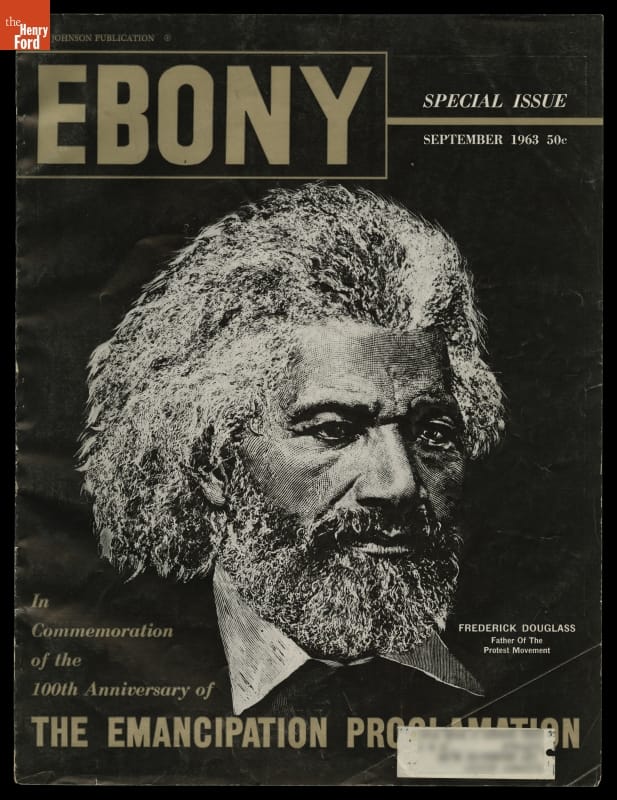
Frederick Douglass remains a powerful symbol of the fight for racial justice and equality. Here, his image graces the cover of Ebony Magazine’s issue celebrating the 100th anniversary of the Emancipation Proclamation. / THF98736_REDACTED
Katherine White is Associate Curator, Digital Content, at The Henry Ford. She appreciated the recently published book by David Blight, Frederick Douglass: Prophet of Freedom, as she conducted research for this post.
Maryland, women's history, voting, Massachusetts, education, Civil War, Civil Rights, by Katherine White, books, African American history, Abraham Lincoln, 19th century, #THFCuratorChat


Facebook Comments